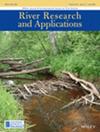Passage through a fishway entrance at different velocities—results from flume experiments with small non‐salmonids
IF 1.9
4区 环境科学与生态学
Q4 ENVIRONMENTAL SCIENCES
引用次数: 0
Abstract
A challenge in the design of fishways especially for large rivers is the trade‐off between attraction and passability of the entrance. High flow velocities in the entrance slot generate a strong attraction flow and tend to have better attraction efficiency for upstream migration. However, these velocities may also prevent small‐bodied species or juvenile fish from entering the fishway. With our experiment, we reproduced fish swimming behaviour and passage of a fishway entrance for small‐bodied fish under realistic hydraulic conditions. At an entrance slot with 0.4 m width four velocities 0.8, 1.2, 1.5 and 1.8 ms以不同速度通过鱼道入口--小型非鲑鱼水槽实验结果
设计鱼道,尤其是设计大江大河的鱼道,面临的一个挑战是如何权衡入口的吸引力和通过性。入口槽中的高流速会产生强大的吸引流,往往对上游洄游具有更好的吸引效率。然而,这些流速也可能会阻碍小体型鱼类或幼鱼进入鱼道。通过实验,我们再现了鱼类的游动行为,以及小体型鱼类在实际水力条件下通过鱼道入口的情况。在宽度为 0.4 米的入口槽中,我们研究了 0.8、1.2、1.5 和 1.8 毫秒-1 四种速度。总共测试了 326 条鳊鱼(Rutilus rutilus (Linnaeus, 1758))、鰕虎鱼(Gobio gobio (Linnaeus, 1758))和麒麟鱼(Alburnoides bipunctatus (Bloch, 1782))幼鱼。三个受测物种的通过率均高于根据报告的游泳能力预测的结果。我们可以看到,三种鱼类的通过率随着流速的增加而降低,这表明鱼类的临界槽速各不相同。尽管如此,这些流速仍低于目前建议的产生足够吸引流量的流速,这可能会对鱼道设计产生影响。
本文章由计算机程序翻译,如有差异,请以英文原文为准。
求助全文
约1分钟内获得全文
求助全文
来源期刊

River Research and Applications
环境科学-环境科学
CiteScore
4.60
自引率
9.10%
发文量
158
审稿时长
6 months
期刊介绍:
River Research and Applications , previously published as Regulated Rivers: Research and Management (1987-2001), is an international journal dedicated to the promotion of basic and applied scientific research on rivers. The journal publishes original scientific and technical papers on biological, ecological, geomorphological, hydrological, engineering and geographical aspects related to rivers in both the developed and developing world. Papers showing how basic studies and new science can be of use in applied problems associated with river management, regulation and restoration are encouraged as is interdisciplinary research concerned directly or indirectly with river management problems.
 求助内容:
求助内容: 应助结果提醒方式:
应助结果提醒方式:


